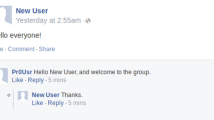Abstract
A hidden group in a communication network is a group of individuals planning an activity over a communication medium without announcing their intentions. We develop algorithms for separating non-random planning-related communications from random background communications in a streaming model. This work extends previous results related to the identification of hidden groups in the cyclic model. The new statistical model and new algorithms do not assume the existence of a planning time-cycle in the stream of communications of a hidden group. The algorithms construct larger hidden groups by building them up from smaller ones. To illustrate our algorithms, we apply them to the Enron email corpus in order to extract the evolution of Enron’s organizational structure.
This material is based upon work partially supported by the National Science Foundation under Grant No. 0324947. Any opinions, findings, and conclusions or recommendations expressed in this material are those of the author(s) and do not necessarily reflect the views of the National Science Foundation.
Preview
Unable to display preview. Download preview PDF.
Similar content being viewed by others
References
Monge, P., Contractor, N.: Theories of Communication Networks. Oxford University Press, Oxford (2002)
Baumes, J., Goldberg, M., Magdon-Ismail, M., Wallace, W.A.: Discovering hidden groups in communication networks. In: Chen, H., Moore, R., Zeng, D.D., Leavitt, J. (eds.) ISI 2004. LNCS, vol. 3073, pp. 378–389. Springer, Heidelberg (2004)
Baumes, J., Goldberg, M., Magdon-Ismail, M., Wallace, W.: On hidden groups in communication networks. Technical report, TR 05-15, CS Dept., RPI (2005)
Capocci, A., Servedio, V.D.P., Caldarelli, G., Colaiori, F.: Detecting communities in large networks. In: Workshop on Algorithms and Models for the Web-Graph (WAW), pp. 181–188 (2004)
Newman, M.E.J.: The structure and function of complex networks. SIAM Review 45, 167–256 (2003)
Girvan, M., Newman, M.E.J.: Community structure in social and biological networks. In: Proc. Natl. Acad. Sci., vol. 99, pp. 7821–7826 (2002)
Magdon-Ismail, M., Goldberg, M., Wallace, W.A., Siebecker, D.: Locating hidden groups in communication networks using hidden markov models. In: Chen, H., Miranda, R., Zeng, D.D., Demchak, C.C., Schroeder, J., Madhusudan, T. (eds.) ISI 2003. LNCS, vol. 2665, pp. 126–137. Springer, Heidelberg (2003)
Baumes, J., Goldberg, M., Krishnamoorthy, M., Magdon-Ismail, M., Preston, N.: Finding comminities by clustering a graph into overlapping subgraphs. In: Proceedings of IADIS Applied Computing, pp. 97–104 (2005)
Baumes, J., Goldberg, M., Magdon-Ismail, M.: Efficient identification of overlapping communities. In: Kantor, P., Muresan, G., Roberts, F., Zeng, D.D., Wang, F.-Y., Chen, H., Merkle, R.C. (eds.) ISI 2005. LNCS, vol. 3495, pp. 27–36. Springer, Heidelberg (2005)
Author information
Authors and Affiliations
Editor information
Editors and Affiliations
Rights and permissions
Copyright information
© 2006 Springer-Verlag Berlin Heidelberg
About this paper
Cite this paper
Baumes, J., Goldberg, M., Hayvanovych, M., Magdon-Ismail, M., Wallace, W., Zaki, M. (2006). Finding Hidden Group Structure in a Stream of Communications. In: Mehrotra, S., Zeng, D.D., Chen, H., Thuraisingham, B., Wang, FY. (eds) Intelligence and Security Informatics. ISI 2006. Lecture Notes in Computer Science, vol 3975. Springer, Berlin, Heidelberg. https://doi.org/10.1007/11760146_18
Download citation
DOI: https://doi.org/10.1007/11760146_18
Publisher Name: Springer, Berlin, Heidelberg
Print ISBN: 978-3-540-34478-0
Online ISBN: 978-3-540-34479-7
eBook Packages: Computer ScienceComputer Science (R0)




